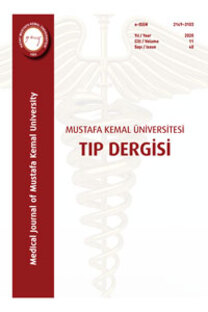Üre döngüsü bozuklukları klinik, laboratuvar ve genetik özellikleri: Tek merkez deneyimi
Amonyak, Üre, Ensefalopati
Urea cycle disorders clinical, laboratory and genetic features: Single center experience
ammonia, urea, encephalopathy,
___
- Brusilow S, Horwich A. Urea cycle enzymes. In The metabolic & molecular bases of inherited disease. 8th edition. Edited by Scriver C, Beaudet A, Sly W, Valle D. New York: McGraw-Hill; 2001:1909–63.
- Noguchi A, Nakamura K, Murayama K, Yamamoto S, Komatsu H, Kizu R, et al. (2016). Clinical and genetic features of lysinuric protein intolerance in Japan. Pediatrics International, 58(10), 979-983. DOI: https://doi.org/10.1111/ped.12946
- Häberle J, Boddaert N, Burlina A, Chakrapani A, Dixon M, Huemer M et al. Suggested guidelines for the diagnosis and management of urea cycle disorders. Orphanet J Rare Dis 2012;7:32. https://doi.org/10.1002/jimd.12100
- Häberle J. Clinical practice: the management of hyperammonemia. Eur J Pediatr 2011, 170:21–34. https://doi.org/10.1007/s00431-010-1369-2
- Bachmann C. Outcome and survival of 88 patients with urea cycle disorders: a retrospective evaluation. Eur J Pediatr 2003 162 :410–16. https://doi.org/10.1007/s00431-003-1188-9
- Saritaş Nakip Ö, Yıldız Y, Tokatlı A. Retrospective evaluation of 85 patients with urea cycle disorders: one center experience, three new mutations. J Pediatr Endocrinol Metab 2020;33:721-728. https://doi.org/10.1515/jpem-2019-0413
- Whitington PF, Alonso EM, Boyle JT, et al. Liver transplantation for the treatment of urea cycle disorders. J Inherit Metab Dis 1998, 21[Suppl 1]:112–18. https://doi.org/10.1023/A:1005317909946
- Nassogne MC, Heron B, Touati G, et al. Urea cycle defects: management and outcome. J Inherit Metab Dis 2005, 28:407–14. https://doi: 10.1007/s10545-005-0303
- Carvalho, D. R., Brum, J. M., Speck-Martins, C. E., Ventura, F. D., Navarro, M. M., Coelho, K. E., ... & Pratesi, R. (2012). Clinical features and neurologic progression of hyperargininemia. Pediatric neurology, 46(6), 369-374. https://doi.org/10.1016/j.pediatrneurol.2012.03.016
- Yu, D., Lu, G., Mowshica, R., Cheng, Y., & Zhao, F. (2019). Clinical and cranial MRI features of female patients with ornithine transcarbamylase deficiency: Two case reports. Medicine, 98(33) https://doi.org/10.1097/MD.0000000000016827
- King, L. S., Singh, R. H., Rhead, W. J., Smith, W., Lee, B., & Summar, M. L. (2005). Genetic counseling issues in urea cycle disorders. Critical care clinics, 21(4), S37-S44. https://doi.org/10.1016/j.ccc.2005.08.001
- ISSN: 2149-3103
- Yayın Aralığı: Yılda 3 Sayı
- Başlangıç: 2010
- Yayıncı: Hatay Mustafa Kemal Üniversitesi Tıp Fakültesi Dekanlığı
COVİD-19 Pnömonisinde Prokalsitonin Düzeylerinin Önemi
Elif DEMİR, Ramazan GİDEN, Zeliha DEMİR
Metin Onur BEYAZ, Senem URFALI, Sefer KAYA, Dilan ORUÇ, Mehmet Selim ÇÖMEZ, Sedat HAKİMOĞLU, Onur KOYUNCU, İsmet Murat MELEK, İyad FANSA
Üre döngüsü bozuklukları klinik, laboratuvar ve genetik özellikleri: Tek merkez deneyimi
Diyabet Hastalarında Hematüri Sıklığı ve Albüminüri ile İlişkisi
Müge ÖZSAN YILMAZ, SERDAR DOĞAN, FARUK HİLMİ TURGUT
COVID-19 Pandemisi Evli Erkeklerin Cinsel Hayatını Nasıl Etkiledi?
MEHMET CANİKLİOĞLU, Levent IŞIKAY, Volkan SELMİ, Sercan SARI, Ünal ÖZTEKİN, Muharrem ÖZKAYA
COVID-19 hastalarında çinko düzeylerinin incelenmesi
Anaplastik Tiroid Karsinomlu Hastalarda Cerrahi Tedavi Yönetimimiz
Serkan ERKAN, Hakan YABANOĞLU, Ramazan GÜNDOĞDU, Murat KUŞ
Hemoroidektomi Sonrası Üriner Retansiyon: Riski Azaltabilir miyiz?
Fatih GÖKALP, Onur KARSLI, Tamer GÜLSUR
Ağır preeklampsiyi öngörmede hemogram inflamatuar belirteçlerin önemi
Umut KUDRET, Mustafa Doğan ÖZÇİL
Yaşlı Evde Sağlık Hastalarında Malnütrisyon Prevalansı ve Malnütrisyon Riski
